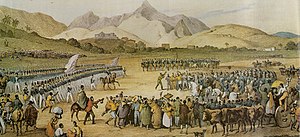Balaiada
| Balaiada Revolt - Brasil | |||||||
|---|---|---|---|---|---|---|---|
 Troops departing from Rio de Janeiro to Maranhão. |
|||||||
|
|||||||
| Belligerents | |||||||
|
|||||||
| Commanders and leaders | |||||||
| Colonel Luís Alves de Lima e Silva | Cosme Bento † Raimundo Gomes |
||||||
| Strength | |||||||
| 10,000-12,000 | 8,000 | ||||||
The Balaiada was a social revolt that occurred between 1838 and 1841 in the interior of the province of Maranhão, Brazil.
During the imperial period, the Maranhão region, which exported cotton, suffered a severe economic crisis because of competition with the increasingly productive United States. In addition, the cattle industry consumed a large part of the workforce in this region. These factors explain the involvement of the slave and poorly paid free workers in the movement.
A political power dispute arose in the heart of the elite class, which was reflected in Maranhão by the opposition of liberals (bem-te-vis) and conservatives (cabanos). When Pedro de Araújo Lima, Marquis of Olinda became prime minister, provoking the so-called regresso conservador ("conservative regression"), the Maranhão conservatives took advantage of the opportunity to remove the liberals in power, and at the same time, weaken them further by contracting the service of the cattle ranchers, traditionally supported by the liberals.
...
Wikipedia
